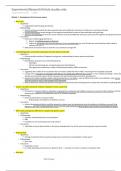Class notes
Brain & behavior II
- Course
- PSYC370 (PSYC370)
- Institution
- Queen’s University (QU )
Covers a range of topics including: -Development of the nervous system -Brain damage and neuroplasticity -Learning, memory and amnesia -Hunger, Eating and Health -Drug use, drug addiction and the brain's reward circuits -Hormones and sex -Sleep, Dreaming and Circadian rhythms -Biopsycho...
[Show more]



